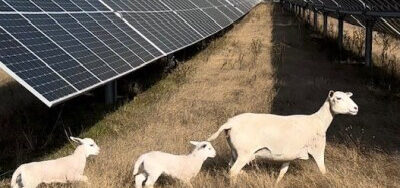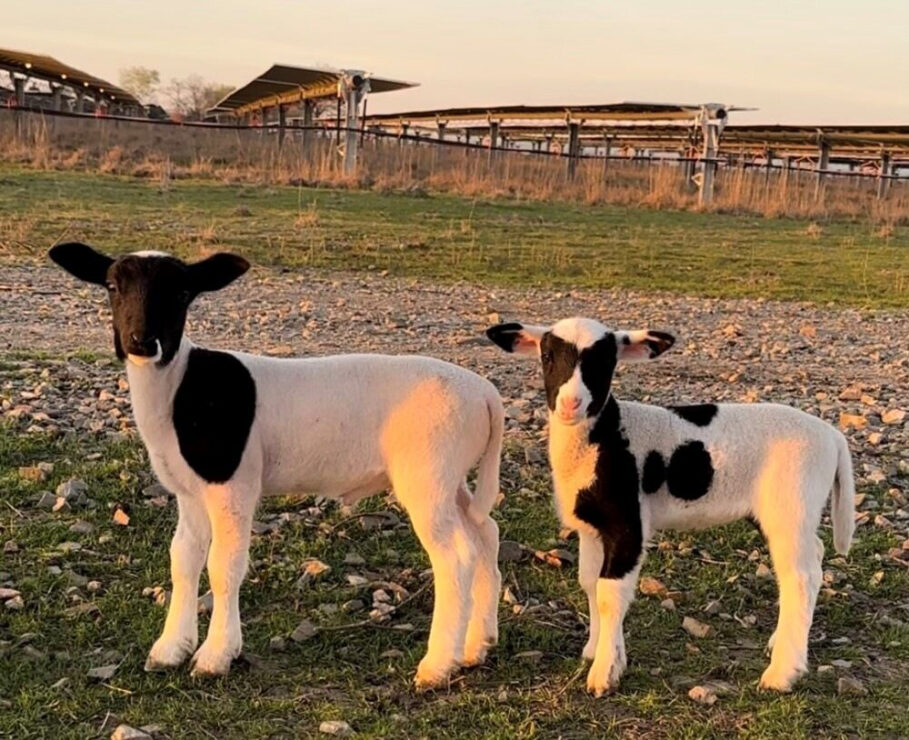
Agrivoltaics is the use of the same land for both agriculture and solar photovoltaic energy generation. Sometimes called agrisolar, dual-use solar, or agri-PV, agrivoltaic projects can help farmers diversify their income, enhance agricultural production, promote biodiversity and more. Examples of agrivoltaic strategies include growing crops between and below solar module rows, incorporating native pollinator species into revegetation plans, and grazing for ongoing vegetation management.
Impact Solar Case Study
At Lightsource bp’s Impact Solar in Deport, Texas, sheep are taking on tough vegetation management roles that previously had mowers stuck in the mud. In an area that can receive up to 47 inches of rain per year, standing water and tall vegetation made it challenging for maintenance crews to navigate mowers safely or efficiently around the project site. In March 2022, SOLV Energy began working with the project owner and South Texas Curbing to introduce Dorper and Katahdin sheep to the site. Today, Impact is host to over 2,000 sheep that successfully keep vegetation under the ideal 18 inches with only targeted mowing in areas with stubborn weeds.
Utilizing sheep on Impact Solar resulted in a reduction of both time and resources, as sheep stepped up to maintain acceptable vegetation heights. The improved vegetation management, but also the risk of various safety and ecological impacts such as fire and erosion. Incorporating grazing into our vegetation management strategies has enabled technicians to focus on plant performance and equipment maintenance, lowering overhead costs and increasing value for the plant owner.
Your Partner in Sustainability
At SOLV Energy, our Sustainability Solutions team collaborates across our EPC and services divisions to ensure that our teams are best prepared to support our clients moving forward. As more project developers begin take a long-term view of the entire lifecycle of solar facilities, we're seeing land management practices increasingly prioritized not only in operation and maintenance strategies, but also early in the project planning and design stages.
Our team works with clients and stakeholders to successfully incorporate appropriate agrivoltaics strategies into project plans. When appropriate, we recommend that clients work with soil scientists and Vegetation Consultants (VC) early in a project to ensure that revegetation plans align with operational goals. As a project progresses through pre-construction and permitting, site-specific erosion mitigation procedures can be implemented. Examples include “low-grow, low-mow” drought-tolerant native seed selection for array areas, pre-designated pollinator-friendly areas, and grazing-compatible species – all of which will help to promote soil health, carbon sequestration, and biodiversity.
A Stakeholder Win-Win
Our Government Affairs team has observed a notable upswing in proposed legislation promoting the widespread adoption of agrivoltaics on both a state and federal level. The Department of Energy is emphasizing the deployment of agrivoltaics, pursuing avenues for cost reduction, and allocating funding for technological innovations. The current Congress has also seen the introduction of agrivoltaic-focused legislation in the Senate. These developments underscore a strong stakeholder drive for agrivoltaic adoption, supported by federal initiatives, legislative action, and research expansion. This is a pivotal opportunity to further the integration of renewable energy and agriculture, creating value for both sectors and the environment.
At Impact Solar and nearly a dozen utility solar facilities across the country, our clients and project stakeholders are witnessing the value that grazing, pollinator-friendly species and other agrivoltaic practices are bringing to their bottom line. Agrivoltaics are a win-win -- for clients, for solar workers, and for our environment - and we're excited to continue to optimize the way we engineer, procure, build, operate and maintain renewable energy projects for our partners.
 Back to all news
Back to all news
